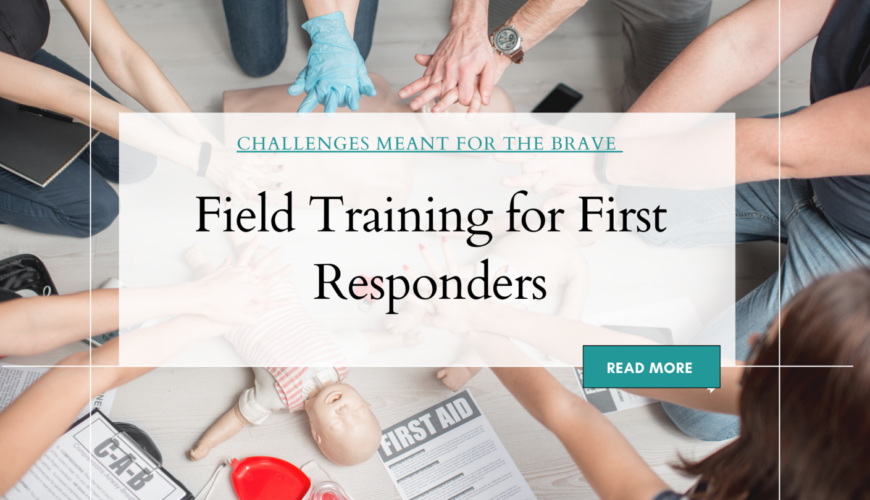Field training for first responders is the crucible where theory meets reality—a dynamic transition from textbooks to tangible experience. Picture the first day on the job, a call to manage an unexpected disaster—this is the scenario field training simulates. It’s not just about reacting; it’s about excelling under pressure.
In this exploration, we delve into the critical transformation from classroom savvy to street smarts, uncovering the nuts and bolts of field training for first responders that lay the groundwork for responders to become the heroes communities rely on in times of crisis.
Table Of Contents:
- The Essence of Field Training for First Responders
- Challenges Meant for the Brave
- The Evolution from Hopefuls to Heroes
- The Community Impact
- Conclusion
- Explore MdE, Inc.’s ADORE™ Software
The Essence of Field Training for First Responders
Responder training serves as the bridge between theoretical knowledge and practical application. While the classroom provides a solid foundation, the unpredictable nature of emergencies demands hands-on experience. This stage of training is where future first responders learn to navigate the complex web of challenges they’ll face in the field. In the realm of emergency management, the significance of responder training becomes even more pronounced.
These individuals undergo rigorous simulations and exercises, mimicking real-life crisis scenarios, to hone their decision-making skills and enhance their ability to coordinate with various agencies seamlessly. From managing large-scale disasters to handling localized incidents, responder training in emergency management ensures that those on the front lines are well-equipped to respond effectively to the diverse challenges that may arise. It cultivates a mindset of adaptability and resilience, preparing individuals to think on their feet and collaborate efficiently during high-stakes situations.
As the training progresses, emphasis is placed not only on technical proficiency but also on fostering a strong sense of teamwork and communication, essential elements for a well-coordinated emergency response effort. Ultimately, responder training in emergency management serves as the linchpin that transforms theoretical knowledge into the practical skills necessary for safeguarding communities and minimizing the impact of unforeseen crises.
Real-World Scenarios
A key objective of field training is to immerse trainees in real-world scenarios that extend beyond the limitations of textbooks. Rather than grappling with hypothetical situations on paper, trainees engage in simulations that authentically replicate the chaos and urgency of genuine emergencies. This hands-on approach serves to not only refine their skills but also to enhance their capacity for making crucial split-second decisions. This holds especially true in the realm of law enforcement and public safety, where the ability to navigate dynamic situations is paramount.
Learning Beside Seasoned Pros
Participating in Field Training for First Responders presents an invaluable chance for trainees to glean wisdom from seasoned professionals who have navigated numerous emergencies. Trainees not only receive instruction on theoretical concepts but also benefit from the firsthand experiences of those who have confronted challenges on the front lines and in training courses. This mentorship dynamic introduces a human touch to the learning process, providing insights that extend beyond the scope of traditional classroom teachings. This holds true not only in public safety but also in the private sectors, where the transfer of real-world expertise becomes a pivotal aspect of professional development.
Trainees are not only taught theoretical concepts but also gain insights from the firsthand experiences of those who have been on the front lines.
Challenges Meant for the Brave
Field Training for First Responders is not for the faint of heart. It presents challenges that push trainees to their limits, testing both their physical and mental fortitude. These challenges are designed to prepare individuals for the harsh realities they may encounter in the field, fostering resilience and adaptability.
Physical Endurance
Responding to emergencies often requires physical strength and stamina. Field training includes physically demanding exercises that mimic the conditions responders may face during actual crises. Whether it’s navigating rough terrain, carrying equipment, or assisting victims, trainees build the physical endurance necessary for the demands of the job.
Emotional Resilience
First responders frequently encounter emotionally charged situations. Field training exposes trainees to scenarios that elicit a range of emotions, from fear and stress to empathy and compassion. Learning to manage these emotions is crucial for maintaining focus and composure during high-pressure situations.
Whether it’s navigating rough terrain, carrying equipment, or assisting victims, trainees build the physical endurance and emotional resilience necessary for the demands of the job.
The Evolution from Hopefuls to Heroes
Field training is where hopeful individuals transform into capable heroes. The journey from a novice responder to a seasoned professional involves overcoming obstacles, gaining practical experience, and developing the confidence to tackle any challenge head-on.
Confidence Building
The immersive nature of field training instills a sense of confidence in trainees. As they successfully navigate realistic scenarios, make critical decisions, and collaborate with experienced mentors, their self-assurance grows. This newfound confidence becomes a cornerstone for effective leadership and decision-making in the field.
Team Collaboration
Field Training First Responders emphasizes the importance of collaboration within a team. Responding to emergencies requires seamless coordination among team members. Through simulations and hands-on exercises, trainees learn to communicate effectively, share responsibilities, and trust their teammates. This collaborative spirit is fundamental to the success of any response effort.
The immersive nature of field training instills a sense of confidence in trainees. As they successfully navigate realistic scenarios, make critical decisions, and collaborate with experienced mentors, their self-assurance grows. This newfound confidence becomes a cornerstone for effective leadership and decision-making in the field.
The Community Impact
The ultimate goal of field training is to prepare first responders to make a positive impact on the communities they serve. The skills and knowledge gained during training become tools that responders use to protect and support their communities during times of crisis.
Community-Centric Training
Field training programs are designed to be community-centric. This means tailoring scenarios to reflect the specific challenges and risks faced by the communities in which responders will serve. By understanding the unique dynamics of their assigned areas, trainees can better address the needs of the people they are sworn to protect.
Rapid Response and Recovery
The effectiveness of first responders in a crisis often hinges on their ability to provide a rapid and organized response. Field training equips responders with the skills to assess situations quickly, make informed decisions, and implement effective strategies for both immediate response and long-term recovery.
Field training equips responders with the skills to assess situations quickly, make informed decisions, and implement effective strategies for both immediate response and long-term recovery.
Conclusion
Field training for first responders is the linchpin in the journey from classroom theory to practical heroism. It shapes individuals into competent, confident, and resilient professionals who stand ready to face the challenges of the unpredictable world of emergency response. As we peel back the curtain on this rigorous journey, we find that it’s a path reserved for the brave—the men and women who willingly step into chaos to ensure the safety and well-being of their communities.
The commitment to excellence doesn’t end with initial training; instead, it extends into the realm of continuing education. In the dynamic landscape of public safety, staying abreast of the latest developments, technologies, and best practices is paramount. Ongoing education and professional development serve as crucial components in ensuring that first responders remain at the forefront of their field. By engaging in continuing education programs, these dedicated professionals can refine their skills, deepen their knowledge, and adapt to emerging trends in emergency management.
The importance of this continuous learning cycle becomes evident when considering the evolving nature of threats and disasters. Whether it’s responding to natural disasters, pandemics, or acts of terrorism, first responders must remain agile and well-informed. Continuing education not only sharpens their expertise but also fosters a culture of innovation and preparedness within the realm of public safety.
In the grand tapestry of emergency response, the dedication of first responders, coupled with ongoing education, weaves a narrative of resilience and adaptability. It’s a narrative that underscores their unwavering commitment to safeguarding communities and underscores the vital role they play in maintaining public safety, even in the face of the unforeseen and ever-changing challenges that lie ahead.
Explore MdE, Inc.’s ADORE™ Software
In the ever-evolving landscape of emergency response, paperwork and documentation can become overwhelming for training officers. Enter ADORE™—AutomateD Observation Reports and Evaluations—a revolutionary software solution designed by MdE, Inc. With 19 years of experience specializing in training software for EMS and other public safety officials, MdE understands the unique needs of the industry.
Empower your team, streamline your processes, and enhance the effectiveness of your training programs with ADORE™. Click here to explore how ADORE™ can revolutionize the way you handle evaluations and observation reports, allowing your training officers and first responders to focus on what they do best—keeping communities safe.
In the grand narrative of emergency response, let ADORE™ be the catalyst that propels your training programs into a future of efficiency, excellence, and unwavering commitment to public safety.


